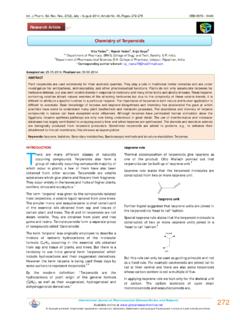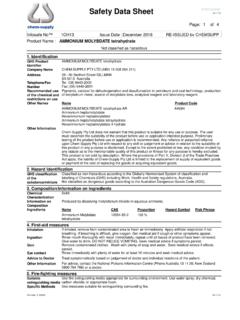Transcription of DATA SHEET PREDNISONE - Medsafe Home Page
1 DATA SHEET . PREDNISONE . 1 mg, mg, 5 mg and 20 mg tablets Presentation PREDNISONE 1 mg tablet: White, or almost white, round tablet with one face embossed "1" and the other embossed "P". Diameter PREDNISONE mg tablet: White, or almost white, round tablet with one face embossed " " and the other embossed "P". Diameter PREDNISONE 5 mg tablet: White, or almost white, round tablet with one face embossed "5" and the other embossed "P". Diameter PREDNISONE 20 mg tablet: Pink, round tablet with a bisecting score on one face and a "P" on the other. Diameter PREDNISONE 20mg tablets contain FD & C Red colouring. PREDNISONE tablets are gluten-free. Uses Actions PREDNISONE is a synthetic glucocorticoid obtained by dehydrogenation of cortisone at positions 1 and 2. It is biologically inert. Anti-inflammatory, immunosuppressant and mineralcorticoid properties are only exhibited when PREDNISONE is converted to prednisolone in the liver. Prednisolone is extensively bound to plasma proteins although less so than hydrocortisone (cortisol).
2 Prednisolone is a potent therapeutic agent influencing the biochemical behaviour of most tissues of the body. Unlike hydrocortisone, prednisolone has little sodium retaining activity. Prednisolone has a biological half-life lasting several hours, intermediate between those of cortisone (cortisol) and the longer acting glucocorticoids, such as dexamethasone. It is this intermediate duration of action which makes it suitable for the alternate-day administration regimens which have been found to reduce the risk of adrenocortical insufficiency, yet provide adequate corticosteroid coverage in some disorders. Pharmacokinetics PREDNISONE is readily absorbed from the gastrointestinal tract and is then converted to its active metabolite prednisolone, by hydrogenation of the ketone group at position 11, in the liver. The preconversion biological half-life of PREDNISONE is about 60 minutes. Prednisolone is excreted in the urine as free and conjugated metabolites together with an appreciable proportion of unchanged prednisolone.
3 Prednisolone has a usual plasma half-life of 2 to 4 hours. A recent review of the pharmacokinetics of PREDNISONE and prednisolone concluded that the conversion of PREDNISONE is probably not diminished by liver disease. Indications PREDNISONE is indicated wherever corticosteroid therapy is considered necessary eg. Skin: Pemphigus vulgaris, allergic dermatitis, eczema, exfolliative dermatitis, dermatitis herpetiformas, dermatitis medicamentosa, erythema multiforme, disseminated lupus erythematosus, dermatomyositis, polyarteritis nodosa. Respiratory: Severe bronchial asthma and status asthmaticus, emphysema, pulmonary fibrosis. Adrenal: Adrenal hyperplasia (adrenogenital syndrome). Haematological: Idiopathic thrombocytopenic purpura, acquired haemolytic anaemia, acute leukaemia. Other: Nephrotic syndrome, iridochoroiditis ulcerative colitis, rheumatoid arthritis, ankylosing spondylitis, rheumatic fever, gout, periarthritis of the shoulder. Dosage and Administration PREDNISONE is intended for oral administration only.
4 Adults: The initial dose is 5mg to 80mg daily depending on the condition being treated, as a single dose after breakfast, as divided doses, or as a double dose on alternate days. The maintenance dose is usually 5mg to 20mg daily. The dose should be individualised according to the severity of the disease and the patients response rather than by age or body weight. For adrenogenital syndrome: 5 to 10mg a day as a single dose. The usual adult prescribing limit is up to 250mg day. Children: For children up to 18 months of age, dosage has not been established. For children over 18 months, initial dosage is daily, this dosage can be doubled or trebled if necessary, continued until definitive remission occurs. Maintenance dose to daily. A single daily dose is preferable over divided doses, to reduce the likelihood of adrenal suppression. The dose should be taken prior to 9am, to closely mimic the body's own maximum corticosteriod secretion. Giving the dose, usually double pre-determined daily dose, on alternate mornings may also reduce the suppression of the HPA axis.
5 This regimen is not recommended for treatment of haematologic disorders, malignancies, ulcerative colitis, or severe conditions. Patients with known or suspected renal insufficiency, including those already receiving replacement therapy require an increase in dosage or reinstitution of therapy prior to, during and for a time following exposure to stress. Contraindications PREDNISONE is contraindicated in patients with: peptic ulcer, osteoporosis, psychoses or severe psychoneuroses. PREDNISONE is usually contraindicated in the presence of acute infection, unless the patient is on long term PREDNISONE whereupon the dose should be increased to counteract the increased stress of the infection. Administration of live virus vaccines including smallpox is contraindicated in patients receiving immunosuppressive doses of PREDNISONE since the expected serum antibody response may not be obtained. Immunisation procedures may, however, be undertaken in patients who are receiving corticosteroids as replacement therapy.
6 Known hypersensitivity to PREDNISONE , or any of the excipients in the tablet. Warnings and Precautions General Precautions Caution is necessary when oral corticosteroids are used in patients with the following conditions and frequent monitoring is necessary: Hypertension Hypothyroidism Congestive Heart failure or recent myocardial infarction Liver failure Renal insufficiency Diabetes mellitus or in those with a family history of diabetes Osteoporosis Glaucoma Patients with a history of severe affective disorders particularly of steroid induced psychoses Epilepsy and/or seizure disorder Peptic ulceration Previous steroid myopathy Tuberculosis Patients with myasthenia gravis receiving anticholinesterase therapy since PREDNISONE may decrease plasma anticholinesterase activity Patients with thromboembolic disorders Patients with Duchenne's muscular dystrophy since transient rhabdomyolysis and myoblobinuria have been reported following strenuous physical activity Patients with Cushing's disease Adrenocortical Insufficiency Pharmacologic doses of corticosteroids administered for prolonged periods may result in hypothalamic-pituitary-adrenal (HPA) suppression (secondary adrenocortical insufficiency).
7 The degree and duration of adrenocortical insufficiency produced is variable among patients and depends on the dose, frequency, time of administration and duration of therapy. Symptoms of adrenal insufficiency include: malaise, muscle weakness, mental changes, muscle and joint pain, desquamation of the skin, dyspnoea, anorexia, nausea and vomiting, fever, hypoglycaemia, hypotension and dehydration. During prolonged courses of corticosteroid therapy sodium intake may need to be reduced and calcium and potassium supplements may be necessary. Monitoring of fluid intake and output and daily weight records may give an early warning of fluid retention. Acute adrenal insufficiency leading to a fatal outcome may occur if glucocorticoids are withdrawn abruptly, therefore withdrawal of PREDNISONE should always be gradual. A. degree of adrenal insufficiency may persist for 6 to 12 months; therefore in any situation of stress occurring during that period steroid therapy may need to be reinstituted.
8 Since mineralocorticoid secretion may be impaired treatment with salt and/or a mineralocorticoid may also be needed. During prolonged therapy, any intercurrent illness, trauma or surgical procedure will require a temporary increase in dosage. Anti-inflammatory/ Immunosuppressive effects and Infection Suppression of the inflammatory response and immune function increases susceptibility to infections and their severity. The clinical presentation may often be atypical and serious infections such as septicaemia and tuberculosis may be masked and may reach an advanced stage before being recognized when corticosteroids including PREDNISONE are used. The immunosuppressive effects of glucocorticoids may result in activation of latent infection or exacerbation of intercurrent infections. Chickenpox is of particular concern since this may be fatal in immunosuppressed patients. Patients without a definite history of chickenpox should be advised to avoid close personal contact with chickenpox or herpes zoster and if exposed they should seek urgent medical attention.
9 Passive immunization is recommended for non- immune patients who do come into contact with chickenpox. If a diagnosis of chickenpox is confirmed the illness warrants specialist care and urgent treatment. Live vaccines are contraindicated in individuals on high doses of corticosteroids and should be postponed until at least 3 months after stopping corticosteroid therapy. Ocular Effects Prolonged use of corticosteroids may produce subcapsular cataracts and nuclear cataracts (particularly in children), exophthalmos or increased intraocular pressure, which may result in glaucoma with possible damage to the optic nerves. Corticosteroids should only be initiated in patients with ocular herpes simplex with appropriate viral cover by ophthalmologists because of the risk of corneal scaring loss of vision and corneal perforation. Psychiatric effects Patients and/or careers should be warned that potentially severe psychiatric reactions may occur. Symptoms typically emerge within a few days or weeks of starting treatment.
10 Most reactions recover after either dose reduction or withdrawal, although specific treatment may be necessary. Patients and/or carers should be encouraged to seek medical advice is worrying psychological symptoms develop, especially if depressed mood or suicidal ideation is suspected. Particular care is required when considering the use of PREDNISONE in patients with existing or previous history of severe affective disorders. Psychic derangements range from euphoria, insomnia, mood swings, personality changes and severe depression to frank psychotic manifestations. Use in Children Corticosteroids cause growth retardation in infancy, childhood and adolescence, which may be irreversible and therefore long-term administration of pharmacological doses should be avoided. If prolonged therapy is necessary, treatment should be limited to the minimum suppression of the hypothalamo-pituitary adrenal axis and growth retardation, the growth and development of infants and children should be closely monitored.
















